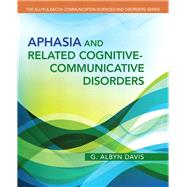In Aphasia and Related Cognitive-Communication Disorders, renowned author Albyn Davis gives graduate students and others pursuing a clinical career in adult language disorders, a comprehensive, up-to-date look at theory and practice in a balanced treatment of impairment-based and communication-based disorders. Written in a relaxed writing style, the book presents topics in an organized, logical progression that first provides an understanding of a disorder, next discusses assessment and diagnosis, and then treatment. Included are explanatory “walk-throughs” to make challenging concepts clear plus coverage of special topics including therapeutic software and other technologies, levels of evidence, neuroplasticity, new medical treatments, quality of life, and primary progressive aphasia.








